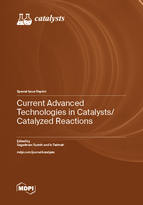Current Advanced Technologies in Catalysts/Catalyzed Reactions
A special issue of Catalysts (ISSN 2073-4344). This special issue belongs to the section "Catalytic Reaction Engineering".
Deadline for manuscript submissions: closed (30 September 2022) | Viewed by 40880
Special Issue Editors
Interests: nanomaterials; nanocomposites; photocatalysis and functional materials
Special Issues, Collections and Topics in MDPI journals
Special Issue Information
Dear Colleagues,
Looking at the current challenges and future opportunities, there has been a strong demand for the development of totally new catalytic technologies by replacing or further improving the existing ones. The present increase of public concern for the environment due to the effects of chemicals and industrial emissions has called for the discovery and development of sustainable processes that can empower us to eliminate, or at least minimize, the use and release of hazardous substances into the environment. This concern with the environment and the supply of raw materials is also focusing attention on the opportunities of recycling and reusing. The chemical industry is the prospect of producing polymers that are readily recyclable and reusable of particular interest. The world supply of petroleum and its products are not adequate for the current demands and so there is a strong need to continue the search for alternative technologies that will permit the conversion of methane, shale, and coal-based traditional ones into liquid fuels at an acceptable cost. Additionally, to maintain economic competitiveness, it is necessary to shift the lower-cost feedstocks for the production of commodity and fine chemicals to provide employment to the rural population and to make them economically balanced. Taken together, these forces have the potential to provide a strong incentive for an increase of research efforts aimed at the discovery of novel catalysts and sustainable catalytic processes. In that view, the market for clean energy and industrial catalysts can be categorized into three major sectors: chemicals, fuels, and environmental protection. The same classification can be used in the sections that follow to discuss new opportunities in catalytic technology. New catalytic discoveries have the significant advance of bringing conceptual advances or molecular insights to catalytic processes wherever appropriate and, thereby, demonstrating the relationship between synthesis, structure, and performance of the catalytic systems. In this, the kinetics and mechanisms are considered to be the central part of catalysis science and their role in the understanding of developed technologies cannot be ignored.
This Special Issue aims to cover the most recent progress and the advances in the field of heterogeneous, homogeneous, organocatalysis, catalyst discoveries; catalytic processes; catalyst mechanism; and biocatalysis communities, containing a balanced mix of fundamental, technology-oriented, liquid fuels; industrial emissions; clean environment; experimental, and computational catalysis.
Prof. Dr. Suresh Sagadevan
Prof. Dr. Is Fatimah
Guest Editors
Manuscript Submission Information
Manuscripts should be submitted online at www.mdpi.com by registering and logging in to this website. Once you are registered, click here to go to the submission form. Manuscripts can be submitted until the deadline. All submissions that pass pre-check are peer-reviewed. Accepted papers will be published continuously in the journal (as soon as accepted) and will be listed together on the special issue website. Research articles, review articles as well as short communications are invited. For planned papers, a title and short abstract (about 100 words) can be sent to the Editorial Office for announcement on this website.
Submitted manuscripts should not have been published previously, nor be under consideration for publication elsewhere (except conference proceedings papers). All manuscripts are thoroughly refereed through a single-blind peer-review process. A guide for authors and other relevant information for submission of manuscripts is available on the Instructions for Authors page. Catalysts is an international peer-reviewed open access monthly journal published by MDPI.
Please visit the Instructions for Authors page before submitting a manuscript. The Article Processing Charge (APC) for publication in this open access journal is 2700 CHF (Swiss Francs). Submitted papers should be well formatted and use good English. Authors may use MDPI's English editing service prior to publication or during author revisions.
Keywords
- Heterogeneous catalysis
- Homogeneous catalysis
- Catalyst characterization
- Catalysis kinetics
- Catalytic processes
- Catalyst mechanism
- Environmental catalysis
- Biocatalysts
- Computational catalysis
- Green catalysis
- Green chemistry







